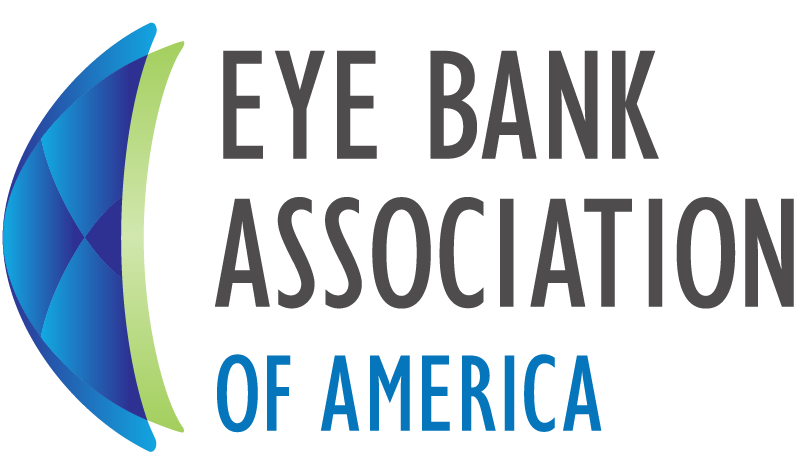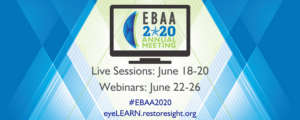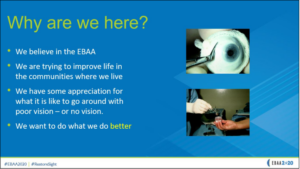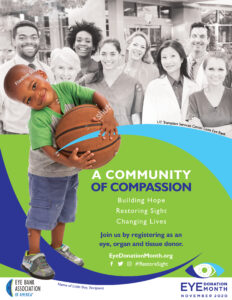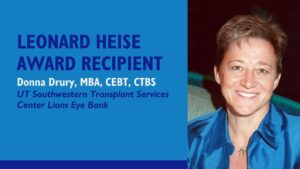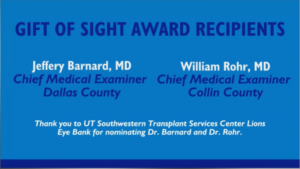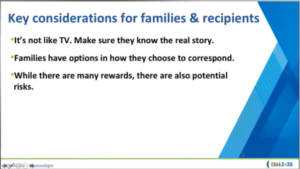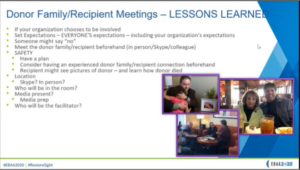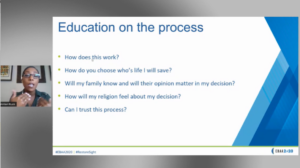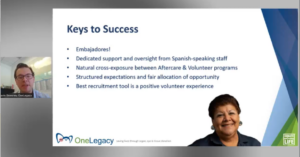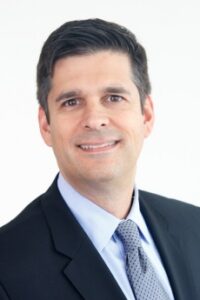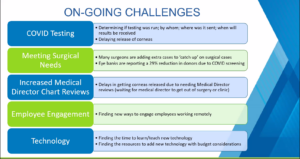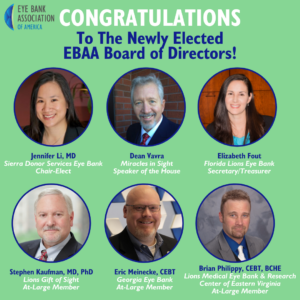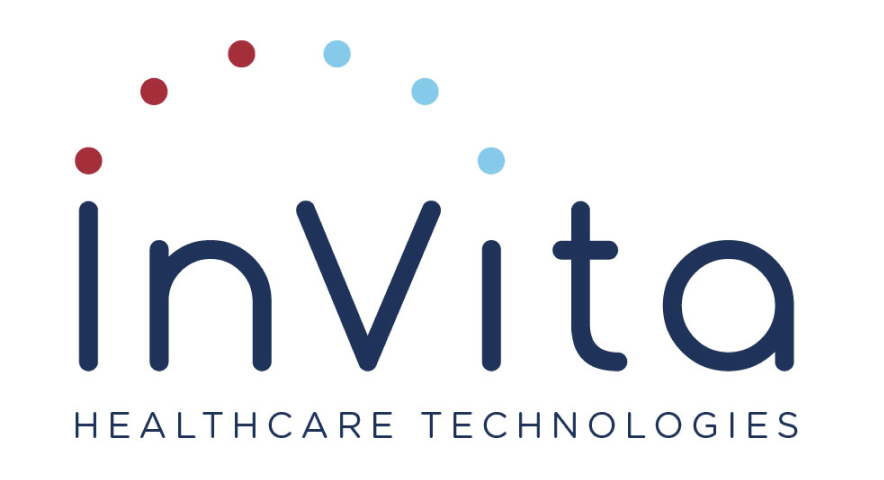This year, because of covid-19, the ebaa annual meeting is an entirely virtual event. follow along here as we recap highlights of the three days of live sessions.
Saturday, June 20, 2020
General Session
New EBAA Chairperson Noel Mick emphasized that EBAA is well equipped to move forward supporting its members in the future. The Board decided to invest in strong branding and messaging to expand the recognition of EBBA’s value and importance in the field of eye banking.
Global Cornea Blindness
Dr. Gerald Sutton
 Around the world, cornea blindness is a major issue – impacts 10 million people globally. 53% of the world’s inhabitants do not have access to corneal transplantation.
Around the world, cornea blindness is a major issue – impacts 10 million people globally. 53% of the world’s inhabitants do not have access to corneal transplantation.
Prevention and innovation are the keys to restoring sight worldwide. But, legislation and governance need to be in place to increase transplant capacity.
Transnational activity – focus should be on local and national self-sufficient services. 22.8% of global transplants involve imported corneal tissue.
Future possibilities: iFixInk pen, bioengineered cornea. Need to do more than making it easier/better/faster to import tissue.
When feeling frustrated, take yourself back to the. “Why?” Efforts are all for ridding the world of cornea blindness.
A Sister’s Life-Changing Gift
Drew Timmons, Donna Drury, Joshua Zaffos, and Shannon Hartley
 UT Southwestern Transplant Services shared the story of Shannon Hartley. Shannon had a cornea transplant as a child, but her body rejected it, and she knew she’d need another transplant down the line.
UT Southwestern Transplant Services shared the story of Shannon Hartley. Shannon had a cornea transplant as a child, but her body rejected it, and she knew she’d need another transplant down the line.
On July 13, 2018 Shannon got her 2nd transplant – her donor was a wife and mother named Shelly – who also happened to be Shannon’s sister.
“It’s an honor and privilege for me to share my story,” Shannon says, “You never know whose life you could touch or make better by organ donation.”
“My sister is always in my heart. But now she’s also in my sight”
Shelly’s other organs saved multiple other lives in the United State and also overseas.
Organ donation is the ultimate selfless act.
Dr. Zaffos heard Shannon’s story and knew he had to help and coordinate with UT Southwestern Transplant Services to make this special corneal transplant happen. Shannon’s story is a constant reminder of why corneal surgeons do what they do, and the miracle of sight restoration.
Scientific Symposium
The Scientific Symposium featured 14 abstracts through on-demand content, and a live session with panel discussions and invited presentations. Browse the Symposia Booklet.
The live presentations and discussions were recorded and will be available following #EBAA2020.
Moderators:
Michelle K. Rhee, MD
Marjan Farid, MD
Panel 1
Albert Cheung, MD
Onkar Sawant, PhD
Doowon Huh, PhD
Anthony Aldave, MD
Peter Bedard, MS
Invited Session SARS-CoV-2 and the Cornea: An Italian Perspective
Diego Ponzin, MD
EBAA Targeted Research Grant on COVID-19: Updates from Investigators
Shahzad Mian, MD
Joshua Hou, MD
Panel 2
Sung Lee
Katie Solley
Philip Dockery, MPH
Joshua Hou, MD
William Waldrop, MD
Emerging Biotech Approaches that may Impact the Future of Corneal Transplantation
Reza Dana, MD, PhD
Panel 3
Cristina Canavesi, PhD, MBA
Angela Chen
Michael A. Puente, Jr., MD
Grace Dunbar, MD
Friday, June 19, 2020 – Day 2
General Session
Kevin Corcoran, EBAA President & CEO
Woodford Van Meter MD, Chairman
Dr. Van Meter delivered the Chair’s address, acknowledging that we should all be in Dallas right now, but have transformed the Annual Meeting during COVID-19 to be together as a community, even from a distance.
EBAA has hit many milestones over the years, including the 2 millionth cornea provided by an EBAA member eye bank in 2019!
Kevin provided the “State of the Association” address, beginning immediately with COVID-19, and how the Association is responding to help eye banks navigate and overcome this crisis.
This year, EBAA has broadened its reach in the international community, taking on a management role of APABO in South America. We’re also working with the European Eye Bank Association (EEBA) on possible educational programming in January.
Last year we established the Ocular Network Exchange (ONE), an eye bank to eye bank online tool helping place tissue. We are now offering to share that technology and platform around the world in places like Australia, Canada, and elsewhere..
Because prevention of blindness is our essential goal, EBAA offers many research funding programs to ensure that our member eye banks are on the forefront of innovation in eye banking and continue to lead the way in moving the profession forward. In aggregate, we’ll provide nearly $140,000 in research support this year.
As always, education is a top priority for EBAA, and we’re hosting educational programs throughout the year both in-person and online.
To better serve our members, we’ll soon transition from using EBAA Connect to E-StatIS as a Statistical Information System. We’re also looking into a Community Platform for all members replacing list-servs for better communication capabilities.
Kevin announced the theme for 2020 Eye Donation Month (November), “A Community of Compassion”.
Expect more materials (especially digital ones!) in the coming weeks and months.
EBAA remains well positioned financially, even with the impact of COVID-19. We secured a Line of Credit for contingency purposes, but do not expect to use it. COVID had a major impact on members, but things are turning around. Eye Banks are back at 71% of their domestic volume, and the average eye bank has 62 weeks of operating capital on hand. Overall, EBAA member eye banks are very confident that they can continue to serve their surgeons effectively.
Finally, Kevin asked whether we get “back to normal?” There really is no “normal,” and eye banks have forever been adapting to change and technological advances. Wishing for “normal” is a trap. We constantly need to evolve and focus on our vision for the future. That’s the overarching theme of our conference; to overcome our challenges through learning, creativity and innovation.
Keynote: Leading With An Eye to the Future with Innovation, Strategy, and Teamwork
Cheryl Cran, Nextmapping
Cheryl Cran is a “future of work” expert. 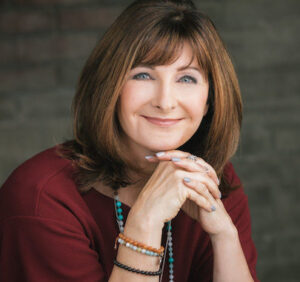
We are in an unprecedented time, filled with change and uncertainty. How do we lead through these challenges? How do we handle this shift to virtual business and keep staff engaged and motivated?
Need to be agile, pivot, and shift to a strategic “change leadership” approach.
The reality is: change is hard!
Top Tools to Cope With Change:
- Focus on what you can control
- Leverage the change cycle for self and others
- Focus on collaboration, innovation, and strategic thinking
- Coach teams to focus on collaboration or ‘we’
Embrace multiple intelligences – all are vital!
- Emotional
- Communication
- Technological
Focus on “we” and commonalities. Think of innovation as a daily activity. Coach and be coached on how to be more resilient.
Recognizing Heise Award Winner, Donna Drury, UT Southwestern Transplant Services Center
If we were in person, Donna would be accepting her Heise Award at our awards dinner. We will be doing something special with Donna and her staff in the future. Congratulations to Donna!
Also, we’d like to recognize our Gift of Sight Awards recipients!
A Lasting Connection Between Two Families
Rosalba Cruz, Nia Zabago, Zoe Zabago, Drew Timmons
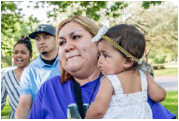 This is the touching video story of Aolani, who passed tragically in a car accident at age 10. However, her mother Rosalba, decided to share the gift of her daughter to help someone else. She made the decision to donate Aolani’s corneas.
This is the touching video story of Aolani, who passed tragically in a car accident at age 10. However, her mother Rosalba, decided to share the gift of her daughter to help someone else. She made the decision to donate Aolani’s corneas.
Zoe, born only a month before Aolani’s death, had cloudy corneas. A specialist diagnosed her with Peters Anomaly – requiring a transplant. She received Aolani’s corneas.
Zoe’s mother, Nia wanted to thank the donor family, and worked with UT Southwestern Transplant Services to arrange a meeting after exchanging letters.
On Saturday, April 15, at the Fort Worth Botanic Garden, the two families were able to meet each other. Zoe went to Rosalba and remained in Rosalba’s arms for most of the event. After the two families had a chance to speak privately, they attended the 15th annual “Garden of Life Spring Celebration Day” which honors donor families and recognizes recipients. During the program, both families shared their story.
As she reflects upon Aolani’s death, Rosalba says, “The only thing I want people to know is even though she died, her death was not in vain. Due to her loss, she was able to change the lives of two other people and their families. I know this is what she would have wanted. I also want others to know that when they have a loss, like mine, think how your loss can change other people’s lives. You don’t know how that person and their family could feel when they get donated the organs or tissues they need. I’m glad my daughter could make it possible for a little girl to be able to see.”
Bringing Recipients and Donor Families Together
Matt Webber, Janice Sedgwick, CEBT, Kristel Gruslin, RN, CTBS, Rebecca Grossman
Lions Vision Gift shared tips on how they’ve digitized their letter files and confirmation cards making it easier to connect and stay in touch with donor families. They’ve started using poetry as a means of emotional understanding and honoring donors.
Changed the text and tone of brochures to be “people focused”. Less facts and figures, more stories of hope explaining why eye banking and the gift of sight is so important.
They send donors and families matching ceramic heart tokens, as a physical reminder of their gift.
It’s key to have proper policies/releases in place so donors and families are fully aware of expectations when meeting.
UT Southwestern Transplant Center leads with a note to the donor family at the time of donation, right after recovery. They follow up a few weeks later with a donation thank you letter after an audit to confirm family information. On the anniversary of the recovery, a handwritten “Remembrance Seed Card” is sent with actual forget-me-not seeds for the family to plant to honor their loved one.
Quotes from donor letters are used to create social media posts, further amplifying the story, and raising awareness about registration.
Georgia Eye Bank shared how they facilitate in-person meetings of families at their office, including signing a wavier explaining the loss of anonymity.
SightLife shared donor family / recipient communication resources. Urged personalization of communications as much as possible. Most common question is, “Why haven’t I heard from my loved one’s recipient/donor family?” Need to explain that sometimes you may never hear from them. This can make some sad or angry. Helps to connect them to other donor families or recipients. Not everyone can emotionally handle communicating with a donor family or recipient. Prepare that someone may say, “no.”
Set expectations – EVERYONE’S expectations – including your organization’s.
Technical Skills & Quality Assurance Workshop
Moderator: Joshua Galloway, CEBT
EBAA member eye banks lead the profession in adhering to the highest standards of tissue screening to protect the health and well being of corneal recipients, ensuring the best outcomes for ocular surgeons. Member eye banks continue to innovate and collaborate with one another, sharing best practices.
The following presentations will be available at the conclusion of #EBAA2020:
Prion Disease and Neurodegeneration
Brian Hitt, MD, PhD
Donor Case Study: Autopsy Findings Suggestive of Probable CJD
Tina Livesay, CEBT
Donor Eligibility Case Studies
Ingrid Schunder, MBA, CEBT
Recovery Technicians: The Face of an Organization
Troy Win’E, CEBT
Qualification of Recovery Partners
Matthew Arnett
Eye Banking at Six Feet Apart: Operations Amidst COVID-19
Kristen Pereira, CEBT, CTBS, CQIA, CQA (ASQ)
Kristin Mathes, MA
Diversity in Donation: Creating Programs that Resonate with Diverse Communities
Kristian Rush, Gavin Sweeney, Sirdaria Williams, Cheryl McGee-Hills, Janice Sedgwick, CEBT
Today is Juneteeth – the date when the last slaves in America were freed – 2.5 years after Lincoln and the Emancipation Proclamation.
At the Louisiana Organ Procurement Organization (LOPA) shared their successful efforts to register donors at EssenceFest in New Orleans last year. Minorities are 60% of the organ wait list – a fact that helped persuade people of color to register as donors.
For two weeks in July, they ran a social media campaign during ECHO dates getting people to urge family and friends to register.
Partnerships with HBCUs and their Communications departments help increase donor registries and educate students. Public Relations classes planned and implemented awareness campaigns complete with traditional and social media aspects. Not only drove registrations and educated, but created on-going relationships with students.
Partnering with Southern Women’s Basketball Team, LOPA hosted a “Donor Awareness Game” uniting a sports audience with the donor community.
Southwest Transplant Alliance in Dallas started the “Know the Truth” educational campaign to connect with the African American community. It focused on facts and “the hard truth” with a video, website, social media accounts, and brochures. Materials were data-specific specific to the African American community.
- Be transparent
- Know your audience
A second video focused on the story featuring a donor family sharing memories of Cameron, a young athlete who passed suddenly while in high school. They were surprised to find out he had checked the box at the DMV to be a donor, and wanted to honor his wishes. A man named Charlie received Cameron’s heart. He was united with Cameron’s family through STA. The video was a great success.
Target audiences need to see themselves on your platforms: website, social media, marketing materials, etc. Partner with events, businesses, and organizations that your audience trusts.
One Legacy created a Spanish-language volunteer ambassador advocacy program for Hispanic and Latino communities. They sought out Hispanic and Latino “activity hubs” throughout their service area. Ambassadors program includes “Change of Heart” media and video campaigns featuring donor and recipient stories. Their efforts have a grassroots community impact with their events, and is more broadly amplified by media.
Donor Cornea Tissue Evaluation
Jonathan Lass, MD, Ahmed Omar, MD, PhD, Adam Stockman, MBA, CEBT, Anthony Vizzerra, CEBT, Amy Asin
These tissue evaluation presentations will be available for viewing at the completion of #EBAA2020.
Thursday, June 17, 2020 – Day 1
Learning Sustains Organizations Through Crisis, Disaster, and Breakdown
D. Christopher Kayes, PhD
Why is learning so important during times of crisis, such as now? How do you use knowledge to navigate a period of crisis?
Learning not only benefits you personally, but it helps your organization financially.
During a crisis you need new solutions – you can’t rely on what you’ve typically been doing. It helps to have a “learning attitude” – a positive association with knowledge and its influence on performance, and a belief that you CAN learn something new.
He uses tennis player Serena Williams to illustrate how to weather highs (improvements) and lows (frustrations) throughout life/career.
Leaders need to foster positive learning attitudes throughout their organizations, and encourage creative solutions.
There are seven learning attitudes:
- Positive emotional engagement
- Creative problem solving
- Learning identity
- Social support
- Focus
- Flexibility
- Recognizing progress
“Learn. It is the only time you cannot fail!” ~ Merlin the Magician
Donation and Transplantation Update: Current Snapshot and Future Outlook
Donna Drury, Kelly Ranum, Diana Buck, Kathy Colby, David Fleming
There’s no denying that COVID-19 has impacted ALL eye banks, however there were different responses depending on each bank’s individual circumstances. The same goes for other donation associations.
The Cornea Society, AOPO, and AATB all shared updates.Ranges of impact vary greatly based on geographic location.
The World Cornea Congress will be delayed until COVID is over.
Donate Life America is working on how to “cut through the clutter” in the news cycle – everything seems to be the same COVID messaging. Using creativity to continue to honor the gift of donors. Covid really hit Donate Life Month (April) plans hard. Focusing on digital and social media outreach.
Transplants dipped hugely during COVID, but numbers are slowly returning to normal. It is yet to be seen how it has impacted donor registration.
Positively, COVID forced all donation associations to innovate quickly and effectively. Using remote technology across the board.
COVID will change how ophthalmology is practiced.Until there is a vaccine, physicians are not able to see as high a volume of patients. Surgeons are being nimble and making adjustments.
Once again, transplants are happening once again both changing and saving lives. Moving forward, donation associations can work together by sharing data, defining best practices (especially with COVID testing), and collaborate to benefit the transplantation community across the board.
Second City Workshop: Collaboration, Innovation, and Dealing with Change
The Second City Performers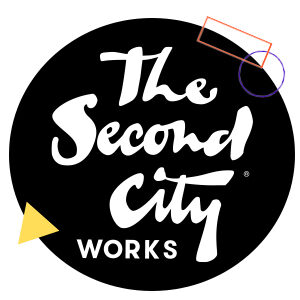
Using improv skills as a way to navigate change, The Second City taught us to embrace the “Yes, and…” mentality to foster ideas, innovate, and create creative “safe spaces” in the workplace.
The session kicked off with a dance to “Can’t Touch This” by MC Hammer, and improv question and answer call backs demonstrating the importance of not judging yourself or others – support one another. Cultivate an environment based around “I’ve got your back.”
Good leaders encourage new ideas and foster innovation. Having ideas turned down and hearing “no” each time makes people very unlikely to keep pitching ideas. Negativity or push back causes people to either dig in or give up. To innovate and adapt to change, you must be careful about word choice or shutting anyone down. It stifles innovation.
Using “yes, but…” can be a negative approach – often feels like a “no.” It’s delivered with the best of intentions, but the result is shutting down ideas. “It’s a no in a tuxedo.”
“Yes, and…” fosters more ideas and allows individuals to elaborate and build upon their idea. It creates a more positive atmosphere. Ideas get bigger and evolve, excitement builds.
Yes doesn’t necessarily mean AGREE, It means “I accept your idea, and I’m willing to build upon it.” Lead with curiosity. Building up ideas leads to innovation. Tearing them down halts it. “Bring a brick, not a cathedral.”
How can you bring creativity into the workspace?
People constantly edit themselves. Editing and judgement prevent us from developing new ideas. Writing a list of 10-20 solutions – no matter how wild, helps creative juices start to flow.
Do you adjust your course as circumstances change? You need to be agile enough to adapt to new information. Everyone has different instincts about change: Fear, anger, excitement, overwhelmed…. When faced with change or rapid change, it can cause anxiety. Using the “Yes, and…” mindset helps – it creates opportunity for creative solutions.
Open yourself to new thought patterns – be agile. See possibilities beyond your own perceptions. Find comfort in the uncomfortable. Think of it as a muscle – you have to practice discomfort.
House of Delegates Meeting
The House of Delegates voted in favor of adopting the by-law amendment allowing elections results to be determined by a plurality.
